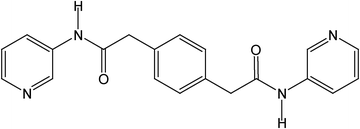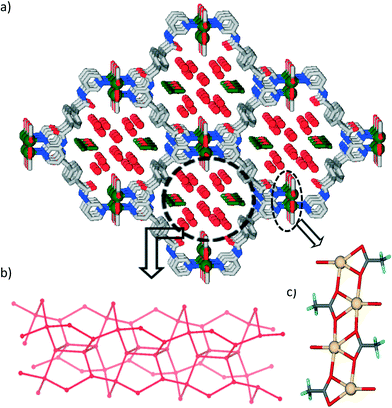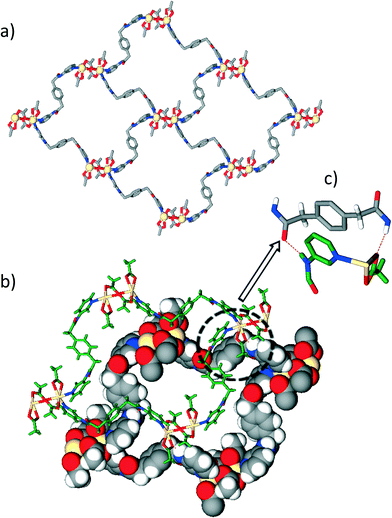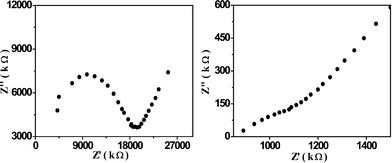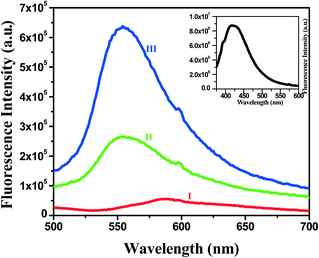One-dimensional water cages with repeat units of (H2O)24 resembling pagodane trapped in a 3D coordination polymer: proton conduction and tunable luminescence emission by adsorption of anionic dyes†
Kartik
Maity
a,
Tanay
Kundu
b,
Rahul
Banerjee
b and
Kumar
Biradha
*a
aDepartment of Chemistry, Indian Institute of Technology, Kharagpur-721302, India. E-mail: kbiradha@chem.iitkgp.ernet.in; Tel: +91 3222 283346
bPhysical/Materials Chemistry Division, CSIR National Chemical Laboratory, Dr. Homi Bhabha Road, Pune 411008, India
First published on 25th May 2015
Abstract
A 3D-coordination polymer was shown to trap one-dimensional polyhedral water cages consisting of repeat units of (H2O)24, the geometry of which resembles the exotic organic molecule pagodane. Further, this material exhibited proton conduction ability and tunable luminescence emission by adsorption of anionic dyes such as the fluorescein dianion.
In recent years special attention has been paid to the design and synthesis of microporous materials, in particular, metal–organic frameworks (MOFs) or covalent organic frameworks (COFs) for gas storage and separation purposes.1 These materials contain well-defined pores and possess the ability to incorporate several guest molecules and assemblies of guest molecules which otherwise can't be realized.2 For example, a variety of water clusters with different sizes and shapes have been reported in the past which afford some information related to the anomalous behaviour of bulk water, but it is still a little understood liquid.3 On the other hand, infinite chains of water molecules, hydrogen bonded water clusters and metal-coordinated water molecules have been shown to have a potential to act as proton carriers under humid as well as anhydrous conditions.4 Proton-conducting materials are of importance for developing electrochemical cells such as fuel cells, electrochemical sensors, electrochemical reactors, and electrochromic devices. Fuel cells are thought to be one of the alternative energy sources for the next generation.5,6 Proton conductivity can mediate the process of conversion of energy from one form into another by involving the transfer of protons in proton exchange membrane fuel cells (PEMFCs) where the proton conducting materials are being used as the membrane electrolyte. Proton conduction within a hydrogen-bonded water cluster is anticipated with the formation of H3O+ within the network where the transfer of a proton occurs with a simultaneous rearrangement between nearby H2O molecules following the Grotthuss or proton-hopping mechanism.7,8
In MOFs and COFs, the hydrophobic nature of the channels/cavities can be effectively tailored toward a hydrophilic nature by introducing functional groups that are capable of forming hydrogen bonds to the backbone of the linear exo-bidentate ligands. The organic backbone in MOFs serves as an anchor for the inclusion and self-organization of free water molecules into various ordered aggregates via hydrogen bonding.9 To date, several varieties of water clusters consisting of discrete assemblies such as tetramers, pentamers, hexamers, octamers, decamers and polyhedral cages, one-dimensional chains and helices and two-dimensional layers have been identified in the crystal lattices of MOFs.10 However, to the best of our knowledge no one-dimensional polyhedral cage structure of water molecules was reported to date. Herein, we report one such example of a 3D-coordination polymer (CP) containing one-dimensional water cages with a repeat unit of (H2O)24, the geometry of which resembles the organic molecule pagodane. Further, this material was also shown to exhibit appreciable proton conductivity and anionic dye adsorption from an aqueous dye solution which helps in fine-tuning the emission properties.
In continuation of our efforts in synthesizing and exploring the properties of CPs containing amide and bis-pyridyl functional groups, the molecule L (Scheme 1) has been synthesized in anticipation of the formation of a 3D-network with hydrophilic channels, due to its inherent flexibility and the presence of amide functionalities in its backbone. The reaction of L (17.32 mg, 0.05 mmol) with Cd(OAc)2 (13.33 mg, 0.05 mmol) in MeOH (10 ml) resulted in single crystals of the coordination polymer 1, {[Cd(L)(OAc)(H2O)]OAc·9H2O}n. Single-crystal X-ray diffraction analysis of 1 revealed that it crystallizes in the C2/m space group, and the asymmetric unit is composed of half unit of L and Cd(II), two half units of two acetate ions, and seven water molecules: three with full occupancy and four with half occupancy (six free and one coordinates to Cd(II)). Among the two acetate ions, one does not coordinate and the other coordinates to Cd(II) in a chelating mode (Cd–O: 2.475 and 2.488 Å) which further bridges to neighbouring Cd(II) ions via μ2-oxo bridging (Cd–O: 2.366 and 2.405 Å) such that it results in the formation of one-dimensional chains of Cd(OAc) units. It is interesting to note here that the crystal structure of Cd(OAc)2·2H2O exhibits such one-dimensional Cd(OAc) chains but the chains are spiral as only one O-atom of the acetate participates in the bridging. To date, no double bridging planar Cd(OAc) chain similar to the one observed in 1 has been reported. Further, the geometry of the chain observed here has a close resemblance to the one that has been observed in a CP of LaNO3.11
As a consequence, each Cd(II) is connected to five O-atoms (four form acetate and one from water) which are in one plane. The two apical positions of Cd(II) are connected to two pyridyl units (Cd–N: 2.288 Å) of L which link these one-dimensional chains into a three-dimensional network containing channels of the dimension 11 × 16.7 Å2, and Cd(II) is overall seven-coordinated with a distorted pentagonal bipyramidal geometry (Fig. 1).
The channels are exclusively occupied by six free water molecules (33% of the crystal volume) and one free acetate ion. The free acetate ion was found to form hydrogen bonds with the N–H groups of L and remains in the channels. Interestingly, the water molecules in the channels exhibited cage-like one-dimensional aggregates, which propagate along the c-axis via Ow–H⋯Ow hydrogen bonds (Table S2†). The repeat unit (H2O)24 of these one-dimensional H2O cages was found to have the geometry of an exotic organic molecule called [2.2.2.2]pagodane (C24H28).12 These one-dimensional chains were anchored by the walls of the channels via O–H⋯O hydrogen bonds between free water molecules and coordinated water molecules, amide O-atoms or free acetate ions. Notably, with the exception of O5w all the other five free water molecules were found to engage in four hydrogen bonds. O5w forms only three hydrogen bonds: two with neighbouring water molecules and one with an amide C![[double bond, length as m-dash]](https://www.rsc.org/images/entities/char_e001.gif) O moiety. Overall, the supramolecular pagodane contains fused rings of six, five and four-membered rings in a 4
O moiety. Overall, the supramolecular pagodane contains fused rings of six, five and four-membered rings in a 4![[thin space (1/6-em)]](https://www.rsc.org/images/entities/char_2009.gif) :
:![[thin space (1/6-em)]](https://www.rsc.org/images/entities/char_2009.gif) 4
4![[thin space (1/6-em)]](https://www.rsc.org/images/entities/char_2009.gif) :
:![[thin space (1/6-em)]](https://www.rsc.org/images/entities/char_2009.gif) 1 combination (Fig. 2). Unlike in covalent pagodane, in non-covalent pagodane the top positions involving O5w are not connected with each other and remain 7.3 Å apart. From TGA analysis it is evident that the crystals of 1 are stable to up to 80 °C and loose the water molecules between 80 to 120 °C (Fig. S4†).
1 combination (Fig. 2). Unlike in covalent pagodane, in non-covalent pagodane the top positions involving O5w are not connected with each other and remain 7.3 Å apart. From TGA analysis it is evident that the crystals of 1 are stable to up to 80 °C and loose the water molecules between 80 to 120 °C (Fig. S4†).
 | ||
| Fig. 2 Illustrations of the water cluster ((H2O)24, pagodane-like) observed in 1: (a) hydrogen bonding (pink lines) between the water molecules in the cluster (red = O and blue = H); (b) ORTEP view of the water cluster (H2O)24; (c) structure of pagodane C24H28 as observed in its crystal structure.12 | ||
Further, single crystal data collection at room temperature also indicates that the water cluster was intact albeit at relatively somewhat higher thermal parameters. In order to verify the source of water molecules in the formation of the crystals of 1, the reaction of L with Cd(OAc)2 was conducted in anhydrous MeOH. This reaction resulted in coordination polymer 2, {[Cd2(L)2(OAc)4]·2MeOH}n. As expected, it does not contain water and forms a 2D-square grid network in which the Cd(II) atoms act as a bimetallic secondary building unit (SBU). The SBUs are linked by L units to form square grids of the dimension 19 × 20 Å2 and the layers are packed onto each other in an off-set mode being interdigitated with each other (Fig. 3). The interdigitated layers interact with each other via amide-to-amide hydrogen bonds (Table S3†).
The presence of highly ordered hydrogen bonded water molecules in close proximity within the hydrophilic cavities of CP 1 prompted us to investigate the proton conductivity (PC) of this material. Recently, it has been shown that CPs containing water chains or clusters have the potential to be good PC materials.4d,e
The PC of CP 1 was calculated by conducting AC impedance analysis on a pressed pellet of the powered sample using a frequency response analyzer via the quasi-four-probe method, at different relative humidities (RHs) and temperatures. The conductivity value was evaluated from the Nyquist plots. The measured PC for this material is about 0.719 × 10−4 S cm−1 at 110 °C and a RH of 98%. However, the conductivity value was found to drop sharply with lowering temperature as well as relative humidity. The drop in PC at lower temperatures and RH values indicates that these factors are important for stimulating the proton-conducting mechanism of the included water molecules in the CP (Fig. 4).
For example, the observed PC of CP 1 at ambient temperature and 60% of RH is 1.02 × 10−5 S cm−1. A temperature dependence study for PC was performed over a temperature range of 25 to 110 °C (RH = 98%). This study revealed that, at 25 °C, it exhibits the lowest PC value (1.52 × 10−5 S cm−1) which increases to a maximum (0.719 × 10−4 S cm−1) as the temperature increases gradually to 110 °C, which is a very rare and desired phenomenon. The PC value is comparable to that of reported Zn–MOFs and Cu–MOFs containing water chains.4d,e
The presence of one-dimensional channels that are occupied by hydrophilic water clusters prompted us to study the dye adsorption ability of these materials from aqueous solutions. For this purpose an anionic dye such as the fluorescein dianion (FSD) was considered, as the network is cationic with one of the acetate ions remaining in the channels.13 Furthermore, it was anticipated that the inclusion of FSD into CP 1 enhances the luminescence of CP 1, resulting in functional materials with electro-optical properties. Therefore, crystals of CP 1 (15 mg) were immersed in an aqueous solution of FSD (10 ml, 10−3 M solution). It was observed that as time progresses the colourless CP changed to an orange-coloured material (3) (Fig. S6†). The single crystals were found to be intact during the adsorption process but not suitable for single crystal X-ray diffraction. The retained network structure of 3 was confirmed by comparing its XRPD with that of CP 1.
The solid-state luminescence properties of 1 and 3 were investigated at room temperature with excitation wavelengths of 350 and 440 nm, respectively. Both were found to display different emission profiles, 1 exhibited the strongest emission peak at 415 nm, whereas 3 shows an intense emission peak at 554 nm (λex = 440 nm). For 3, emission was observed with a red shift by 139 nm, with respect to 1, due to the charge–transfer interactions between the cationic framework and anionic FSD. The emission profile of pure FSD was recorded by exciting it at 440 nm for the sake of comparison with that of 3. Pure FSD was found to exhibit an emission maximum at 586 nm which is in the yellow region (Fig. 5). Therefore, complex 3 (green region) exhibits an emission maximum which is in between that of 1 (violet region) and FSD (yellow region). Such a type of intermediate emission was recently reported for a cationic (DMASM) dye adsorbing MOF.13b It is also interesting to note here that the intensity of emission can also be fine-tuned by controlling the adsorption quantity of the dye. For example, complex 1 exhibits 9 × 106 a.u., while 3, when prepared with a 10−3 M concentration of FSD, shows 6.5 × 105 a.u. The luminescence intensity of 3 is found to be much lower when the material of 3 was prepared by immersing 1 in a highly concentrated aqueous solution of FSD. We note here that the physical mixture of 1 and FSD does not exhibit either such shifting of emission wavelengths or the change in intensity as the emission profile was similar to that of 1 and FSD at excitation wavelengths of 350 and 440 nm, respectively.
In addition to FSD, 1 was also found to adsorb another anionic dye, methyl orange (MO) (Fig. S9, S10†). The solid-state luminescence of MO-adsorbing materials of 1 were also found to exhibit similar emission profiles and trends as those of 3 (Fig. S12†). As a matter of fact, CP 1 did not adsorb cationic dyes such as methylene blue or crystal violet which exemplifies the selectivity of 1 towards the nature of the dye.
In conclusion, the CP 1 reported here exhibited the unique feature of encapsulating one-dimensional water cages in which the repeating unit exhibits the geometry of the organic molecule pagodane. Further, the material 1 shows appreciable proton conductivity due to the presence of such water cages. It also exemplifies the role of the one-dimensional planar chains of Cd(OAc) units in promoting the formation of three-dimensional porous structures. Furthermore, the cationic framework of CP showed the capability of selectively adsorbing anionic dyes, which helps in fine-tuning the emission profiles of these materials. Exploration of the gas sorption properties is underway in our laboratory.
Acknowledgements
We acknowledge DST, New Delhi, India, for financial support, and DST-FIST for the single crystal X-ray diffractometer, and KM thanks UGC for a research fellowship. We also thank Niloy Kundu for luminescence measurements.Notes and references
-
(a) B. Li, H. M. Wen, W. Zhou and B. Chen, J. Phys. Chem. Lett., 2014, 5, 3468 CrossRef CAS
; (b) H. Furukawa, K. E. Cordova, M. O'Keeffe and O. M. Yaghi, Science, 2013, 341, 1230444 CrossRef PubMed
.
-
(a) B. Moulton and M. J. Zaworotko, Chem. Rev., 2001, 101, 1629 CrossRef CAS PubMed
; (b) G. Mukherjee and K. Biradha, Chem. Commun., 2014, 50, 670 RSC
.
-
(a) L. J. Barbour, G. W. Orr and J. L. Atwood, Nature, 1998, 393, 671 CrossRef CAS
; (b) X. Li, X. Xu, D. Yuanb and X. Weng, Chem. Commun., 2012, 48, 9014 RSC
; (c) R. Ludwig, Angew. Chem., Int. Ed., 2001, 40, 1808 CrossRef CAS
; (d) M. Yoshizawa, T. Kusukawa, M. Kawano, T. Ohhara, I. Tanaka, K. Kurihara, N. Niimura and M. Fujita, J. Am. Chem. Soc., 2005, 127, 2798 CrossRef CAS PubMed
; (e) M. Mascal, L. Infantes and J. Chisholm, Angew. Chem., Int. Ed., 2006, 45, 32 CrossRef CAS PubMed
; (f) X.-D. Chen, X.-H. Zhao, M. Chen and D. Miao, Chem. – Eur. J., 2009, 15, 12974 CrossRef CAS PubMed
; (g) L. Cheng, J.-B. Lin, J.-Z. Gong, A.-P. Sun, B.-H. Ye and X.-M. Chen, Cryst. Growth Des., 2006, 6, 2739 CrossRef CAS
.
-
(a) M. Wei, X. Wang and X. Duan, Chem. – Eur. J., 2013, 19, 1607 CrossRef CAS PubMed
; (b) M. Yoon, K. Suh, S. Natarajan and K. Kim, Angew. Chem., Int. Ed., 2013, 52, 2688 CrossRef CAS PubMed
; (c) B. Wu, X. Lin, L. Ge, L. Wua and T. Xu, Chem. Commun., 2013, 49, 143 RSC
; (d) S. C. Sahoo, T. Kundu and R. Banerjee, J. Am. Chem. Soc., 2011, 133, 17950 CrossRef CAS PubMed
; (e) C. Dey, T. Kundu and R. Banerjee, Chem. Commun., 2012, 48, 266 RSC
; (f) S. Horike, D. Umeyama and S. Kitagawa, Acc. Chem. Res., 2013, 46, 2376 CrossRef CAS PubMed
.
-
(a) K. D. Kreuer, Chem. Mater., 1996, 8, 610 CrossRef CAS
; (b) C. H. Lee, H. B. Park, Y. M. Lee and R. D. Lee, Ind. Eng. Chem. Res., 2005, 44, 7617 CrossRef CAS
.
-
(a) K. D. Kreuer, S. J. Paddison, E. Spohr and M. Schuster, Chem. Rev., 2004, 104, 4637 CrossRef CAS
; (b) M. S. Dresselhaus and I. L. Thomas, Nature, 2001, 414, 332 CrossRef CAS PubMed
; (c) A. B. Stambouli and E. Traversa, Renewable Sustainable Energy Rev., 2002, 6, 297 CrossRef
.
-
(a) G. K. H. Shimizu, J. M. Taylor and S. Kim, Science, 2013, 141, 354 CrossRef PubMed
; (b) T. Yamada, W. K. Otsubo, R. Makiurac and H. Kitagawa, Chem. Soc. Rev., 2013, 42, 6655 RSC
; (c) M. A. Hickner and B. S. Pivovar, Fuel Cells, 2005, 5, 213 CrossRef CAS PubMed
.
-
(a) P. Ramaswamy, N. E. Wong and G. K. H. Shimizu, Chem. Soc. Rev., 2014, 43, 5913 RSC
; (b) S. Peighambardoust, S. Rowshanzamir and M. Amjadi, Int. J. Hydrogen Energy, 2010, 35, 9349 CrossRef CAS PubMed
.
-
(a) G. R. Desiraju, Acc. Chem. Res., 2002, 35, 565 CrossRef CAS PubMed
; (b) M. Sarkar and K. Biradha, Cryst. Growth Des., 2006, 6, 1743 Search PubMed
; (c) P. V. Dau, K. K. Tanabe and S. M. Cohen, Chem. Commun., 2012, 48, 9370 RSC
.
-
(a) B. H. Ye, B. B. Ding, Y. Q. Weng and X. M. Chen, Inorg. Chem., 2004, 43, 6866 CrossRef CAS PubMed
; (b) B. Q. Ma, H. L. Sun and S. Gao, Chem. Commun., 2004, 2220 RSC
; (c) S. K. Ghosh and P. K. Bharadwaj, Inorg. Chem., 2005, 44, 5553 CrossRef CAS PubMed
; (d) J. S. Long, Y. R. Wu, R. B. Huang and L. S. Zheng, Inorg. Chem., 2004, 43, 3798 CrossRef PubMed
; (e) J. P. Zhang, Y. Y. Lin, X. C. Huang and X. M. Chen, Inorg. Chem., 2005, 44, 3146 CrossRef CAS PubMed
.
- C. Qin, X. Wang, E. Wang and L. Xu, Inorg. Chim. Acta, 2006, 359, 417 CrossRef CAS PubMed
.
- M. Wollenweber, M. Etzkorn, J. Reinbold, F. Wahl, T. Voss, J. P. Melder, C. Grund, R. Pinkos, D. Hunkler, M. Keller, J. Wörth, L. Knothe and H. Prinzbach, Eur. J. Org. Chem., 2000, 2000, 3855 CrossRef
.
-
(a) Q. R. Fang, G. S. Zhu, Z. Jin, Y. Y. Ji, J. W. Ye, M. Xue, H. Yang, Y. Wang and S. Lun Qiu, Angew. Chem., Int. Ed., 2007, 46, 6638 CrossRef CAS PubMed
; (b) J. Yu, Y. Cui, H. Xu, Y. Yang, Z. Wang, B. Chen and G. Qian, Nat. Commun., 2013, 4, 2719 Search PubMed
.
Footnote |
| † Electronic supplementary information (ESI) available: Experimental, elemental analyses, crystallographic details, XRPD patterns, TGA data and additional structural drawings. CCDC 1058059 and 1058060. For ESI and crystallographic data in CIF or other electronic format see DOI: 10.1039/c5ce00969c |
| This journal is © The Royal Society of Chemistry 2015 |

